





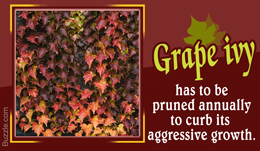 Grape ivy tendrils have suction disks that help the plant cling to surfaces like walls and tree trunks.As the name rightly suggests, grape ivy (Parthenocissus tricuspidata) is a woody vine that belongs to the grape family Vitaceae. Though the berries of this plant are not edible, the plant is grown for ornamental purposes. Grape ivy is not related to true ivy, and is native to Asian countries, like Japan, China, and Korea. It is also called Japanese creeper, Boston ivy, Japanese ivy, etc.The scientific name of the plant indicates its genus (Parthenocissus) and the specific epithet (tricuspidata). The term tricuspidata is derived from the shape of grape ivy leaves, which have three pointed lobes.
Grape ivy tendrils have suction disks that help the plant cling to surfaces like walls and tree trunks.As the name rightly suggests, grape ivy (Parthenocissus tricuspidata) is a woody vine that belongs to the grape family Vitaceae. Though the berries of this plant are not edible, the plant is grown for ornamental purposes. Grape ivy is not related to true ivy, and is native to Asian countries, like Japan, China, and Korea. It is also called Japanese creeper, Boston ivy, Japanese ivy, etc.The scientific name of the plant indicates its genus (Parthenocissus) and the specific epithet (tricuspidata). The term tricuspidata is derived from the shape of grape ivy leaves, which have three pointed lobes.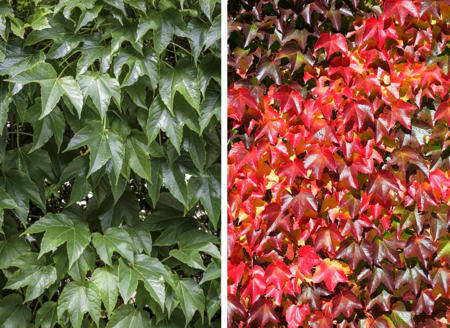 The green summer foliage turns red during autumn.During spring, the plant produces red-colored shoots that turn green as they mature. The foliage remains glossy green throughout the summer. The color of the foliage changes to orange-red during fall. Though the plant retains its leaves during winter, it may shed if the temperature drops too low. A new cultivar named Parthenocissus tricuspidata purpurea has reddish-purple leaves throughout the year. Parthenocissus tricuspidata veitchii is another variety with smaller leaves that turn red during fall. The cultivar named 'Beverly Brooks' has bright red fall foliage and large leaves. However, the cultivars may not be as hardy as the original species.
The green summer foliage turns red during autumn.During spring, the plant produces red-colored shoots that turn green as they mature. The foliage remains glossy green throughout the summer. The color of the foliage changes to orange-red during fall. Though the plant retains its leaves during winter, it may shed if the temperature drops too low. A new cultivar named Parthenocissus tricuspidata purpurea has reddish-purple leaves throughout the year. Parthenocissus tricuspidata veitchii is another variety with smaller leaves that turn red during fall. The cultivar named 'Beverly Brooks' has bright red fall foliage and large leaves. However, the cultivars may not be as hardy as the original species.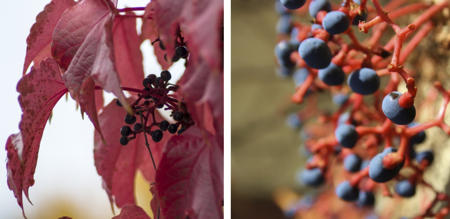 Grape ivy produces blue berries during fall.During summer, the plant produces greenish-yellow flowers that are mostly inconspicuous. Small, blue-colored, round berries appear during fall. The berries develop in clusters on bright red stems. Though they are consumed by birds and small mammals, the berries are toxic for humans. The plant is said to be moderately toxic for cats and dogs too.Grape Ivy Plant CareGrape ivy is a hardy plant that can be grown without much care. It can be grown outdoors as well as indoors. Usually, grape ivy is grown on walls, trellises, fences, pergolas, etc. It can easily grow to a height of around 50 to 60 feet. The plant is best for USDA zones 4 to 8.Soil and SunGrape ivy is tolerant to a wide range of growth conditions. However, they grow well in partial shade to full sun. Those growing in full sun develop bright fall color. Partial shade is preferred in warmer areas. Though it grows in different types of soil; well-drained, loamy soil is preferred for grape ivy. The ideal pH level ranges between 6.1 to 7.5. Mulching is beneficial for retaining the moisture in the soil.Watering
Grape ivy produces blue berries during fall.During summer, the plant produces greenish-yellow flowers that are mostly inconspicuous. Small, blue-colored, round berries appear during fall. The berries develop in clusters on bright red stems. Though they are consumed by birds and small mammals, the berries are toxic for humans. The plant is said to be moderately toxic for cats and dogs too.Grape Ivy Plant CareGrape ivy is a hardy plant that can be grown without much care. It can be grown outdoors as well as indoors. Usually, grape ivy is grown on walls, trellises, fences, pergolas, etc. It can easily grow to a height of around 50 to 60 feet. The plant is best for USDA zones 4 to 8.Soil and SunGrape ivy is tolerant to a wide range of growth conditions. However, they grow well in partial shade to full sun. Those growing in full sun develop bright fall color. Partial shade is preferred in warmer areas. Though it grows in different types of soil; well-drained, loamy soil is preferred for grape ivy. The ideal pH level ranges between 6.1 to 7.5. Mulching is beneficial for retaining the moisture in the soil.Watering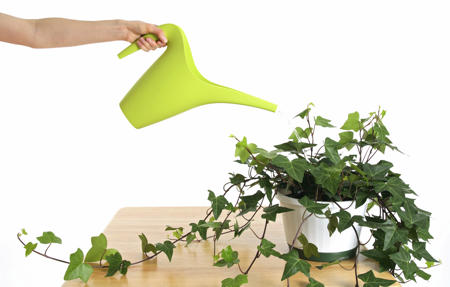 Grape ivy requires frequent watering, till it gets established. Once established, try to keep the soil slightly moist. This can be done by watering the plant once a week during spring and summer. Reduce the frequency of watering during winter and fall. Avoid over-watering, it can cause root rot. In case of a very hot summer, water the plant as and when the soil gets dry. Watering is not a must for established plants.FeedingBeing hardy and self-reliant, the grape ivy plant does not require frequent feeding. Apply a small amount of all-purpose fertilizer once a year during spring. Follow the instructions of the manufacturer regarding the dosage and method of application. Water thoroughly before and after application of fertilizer. Avoid feeding the plant if it grows too fast and is getting invasive.Support
Grape ivy requires frequent watering, till it gets established. Once established, try to keep the soil slightly moist. This can be done by watering the plant once a week during spring and summer. Reduce the frequency of watering during winter and fall. Avoid over-watering, it can cause root rot. In case of a very hot summer, water the plant as and when the soil gets dry. Watering is not a must for established plants.FeedingBeing hardy and self-reliant, the grape ivy plant does not require frequent feeding. Apply a small amount of all-purpose fertilizer once a year during spring. Follow the instructions of the manufacturer regarding the dosage and method of application. Water thoroughly before and after application of fertilizer. Avoid feeding the plant if it grows too fast and is getting invasive.Support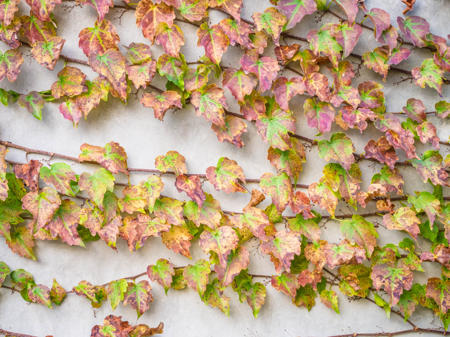 If you want to grow the plant as a climber, it must have proper support. Grape ivy needs a surface to attach its tendrils. Tree trunks, walls made of rocks, bricks, wood, etc., are ideal for growing this plant. Wooden walls may develop mold and get damaged in the long run. Avoid growing grape ivy on painted walls as the suckers will damage the paint. The same applies to walls clad with siding. Grape ivy is ideal as a wall cover if you are looking for a permanent fixture, because removal of established plants can get difficult.Pruning
If you want to grow the plant as a climber, it must have proper support. Grape ivy needs a surface to attach its tendrils. Tree trunks, walls made of rocks, bricks, wood, etc., are ideal for growing this plant. Wooden walls may develop mold and get damaged in the long run. Avoid growing grape ivy on painted walls as the suckers will damage the paint. The same applies to walls clad with siding. Grape ivy is ideal as a wall cover if you are looking for a permanent fixture, because removal of established plants can get difficult.Pruning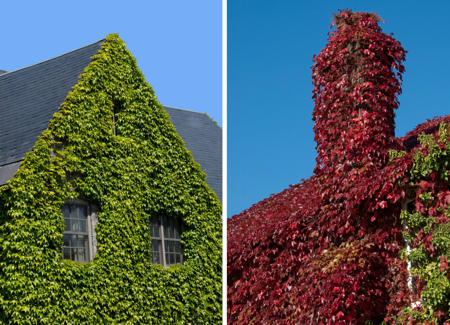 Without proper control, grape ivy may turn invasive.With proper growth conditions, grape ivy grows really fast. It can cover walls and fences within no time. So, pruning is highly necessary to check its unrestrained and aggressive growth. You can remove the new shoots as and when they develop, especially during spring. Hard pruning during winter is good for controlling the growth of the plant. Apart from that, remove diseased and damaged stems. Remove new plants that grow from fallen berries and stem cuttings.PropagationThe easiest way to propagate grape ivy is to use stem cuttings. Try to get cuttings with a length of 4 to 5 inches. All you need to do is to remove the leaves near the cut end. Dip that end in rooting hormone and plant it in a container filled with soilless potting mix. It takes around two weeks for the cutting to develop roots and new leaves. You can transplant it in a pot or in the ground. Another method is to collect the seeds from ripe berries and grow them into new plants during fall. Plant grape ivy saplings at a distance of around 10 feet.Pests and Diseases
Without proper control, grape ivy may turn invasive.With proper growth conditions, grape ivy grows really fast. It can cover walls and fences within no time. So, pruning is highly necessary to check its unrestrained and aggressive growth. You can remove the new shoots as and when they develop, especially during spring. Hard pruning during winter is good for controlling the growth of the plant. Apart from that, remove diseased and damaged stems. Remove new plants that grow from fallen berries and stem cuttings.PropagationThe easiest way to propagate grape ivy is to use stem cuttings. Try to get cuttings with a length of 4 to 5 inches. All you need to do is to remove the leaves near the cut end. Dip that end in rooting hormone and plant it in a container filled with soilless potting mix. It takes around two weeks for the cutting to develop roots and new leaves. You can transplant it in a pot or in the ground. Another method is to collect the seeds from ripe berries and grow them into new plants during fall. Plant grape ivy saplings at a distance of around 10 feet.Pests and Diseases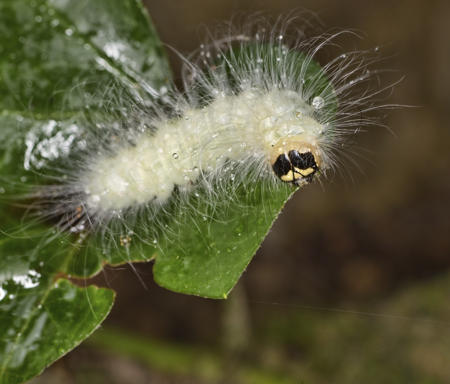 Grape ivy is prone to powdery mildew, downy mildew, canker, leaf spots, etc. They are also get affected by pests like beetles, scales, aphids, caterpillars, and many other insects. Spraying soap solution on the foliage may prove effective for aphids, Japanese beetles, leafhoppers, mites, and scales. For eliminating caterpillars, spray Bacillus thuringiensis on the foliage. They will die within a few days of ingesting these bacteria. Application of sulfur spray may prove beneficial for countering fungal diseases. Consult a horticulturist or the local garden center for proper guidance relating to control of pests and diseases in grape ivy.In short, grape ivy is a hardy plant that can be grown easily. However, it may turn aggressive and cover a whole area in a very short span of time. When grown as a wall cover, grape ivy can cover the whole building including the windows and doors. So, prune them properly at regular intervals. If you want to remove an established grape ivy plant from the wall, don't pull out the vines. One method is to apply a herbicide like glyphosate during late summer. The plant will die within a week or two. Another method is to remove the trailers as well as the leaves and spray white vinegar.
Grape ivy is prone to powdery mildew, downy mildew, canker, leaf spots, etc. They are also get affected by pests like beetles, scales, aphids, caterpillars, and many other insects. Spraying soap solution on the foliage may prove effective for aphids, Japanese beetles, leafhoppers, mites, and scales. For eliminating caterpillars, spray Bacillus thuringiensis on the foliage. They will die within a few days of ingesting these bacteria. Application of sulfur spray may prove beneficial for countering fungal diseases. Consult a horticulturist or the local garden center for proper guidance relating to control of pests and diseases in grape ivy.In short, grape ivy is a hardy plant that can be grown easily. However, it may turn aggressive and cover a whole area in a very short span of time. When grown as a wall cover, grape ivy can cover the whole building including the windows and doors. So, prune them properly at regular intervals. If you want to remove an established grape ivy plant from the wall, don't pull out the vines. One method is to apply a herbicide like glyphosate during late summer. The plant will die within a week or two. Another method is to remove the trailers as well as the leaves and spray white vinegar.
Coneflowers: How to Plant, Grow, and Care for Coneflowers
Cosmos: How to Plant, Grow, and Care for Cosmos
Impatiens: How to Plant, Grow, and Care for Impatiens
Petunias: How to Plant, Grow, and Care for Petunias
Yarrow: How to Plant, Grow, and Care for Yarrow
Copyright © www.100flowers.win Botanic Garden All Rights Reserved